


Notice: This is the official website of the All Empires History Community (Reg. 10 Feb 2002)
The Late Byzantine Military (1204-1461) |
Post Reply 
|
Page <1 14151617> |
| Author | |||||
Justinian 
Chieftain 
King of Númenor Joined: 11-Nov-2005 Location: United States Online Status: Offline Posts: 1399 |
 Quote Quote  Reply Reply
 Topic: The Late Byzantine Military (1204-1461) Topic: The Late Byzantine Military (1204-1461)Posted: 07-Oct-2007 at 20:14 |
||||
|
I read through the entire thread, took a while but fascinating stuff, and didn't see this come up so here is a question-- do we have any idea the manpower available to the individual successors like Nicaea and Trebizond after the conquest by the crusaders in 1204? A follow up to that would be do we know the makeup of their armies; percentage of cavalry, archers, etc.? My knowledge of the military during the late period is negligable so I don't have much to add to this, plenty to ask though. If this is out of place my apologies. Edited by Justinian - 07-Oct-2007 at 20:17 |
|||||
|
"War is a cowardly escape from the problems of peace."--Thomas Mann

|
|||||
 |
|||||
Byzantine Emperor 
Arch Duke 

Kastrophylax kai Tzaousios Joined: 24-May-2005 Location: United States Online Status: Offline Posts: 1800 |
 Quote Quote  Reply Reply
 Posted: 16-Oct-2007 at 16:27 Posted: 16-Oct-2007 at 16:27 |
||||
Justinian, thanks for the reply. I have not been ignoring your post, but have been really busy with school the past few weeks. Please look for my response here soon.
I know right now that there are hardly any numerical data or statistics for the organization of the Trapezuntine army. This is a shame because it would be really interesting to know, especially for the later centuries. There are some numbers for the Nikaean army, which I will have to look up.
|
|||||
 |
|||||
Justinian 
Chieftain 
King of Númenor Joined: 11-Nov-2005 Location: United States Online Status: Offline Posts: 1399 |
 Quote Quote  Reply Reply
 Posted: 17-Oct-2007 at 19:50 Posted: 17-Oct-2007 at 19:50 |
||||
|
No worries, BE. I know how that goes.
|
|||||
|
"War is a cowardly escape from the problems of peace."--Thomas Mann

|
|||||
 |
|||||
Jubelu 
Immortal Guard 
Joined: 08-Jun-2007 Location: Syrian Arab Republic Online Status: Offline Posts: 2 |
 Quote Quote  Reply Reply
 Posted: 21-Oct-2007 at 17:30 Posted: 21-Oct-2007 at 17:30 |
||||
|
Dear Saber
I have never said "linear spears extincted". But let's look at this problem in a more wider scope. "Traditional Spear" which had its long history come to an end under the name "Spear". Since its simple design is no longer suit the new developement of Armour. Pike is NOT Spear, modern schollars classify Pike in different category although we still admit it as an improvement from traditional spear. Polearms, is no longer spear, for its extension spread through axe class as well as hammer class. Thus, the name "spear" after 15th century is no longer appropriate for schollatic research because it is not specified while the diversity of its extensions increased dramatically. |
|||||
 |
|||||
Alkiviades 
Baron 

Joined: 01-Sep-2005 Location: Antarctica Online Status: Offline Posts: 469 |
 Quote Quote  Reply Reply
 Posted: 20-Feb-2008 at 10:38 Posted: 20-Feb-2008 at 10:38 |
||||
|
Extremely interesting topic. Will try and contribute more substantially than just cheering one of these days

|
|||||
|
If you wanna play arrogant with me, you better have some very solid facts to back up that arrogance, or I'll tear you to pieces
|
|||||
 |
|||||
Challenger2 
Colonel 
Suspended Joined: 28-Apr-2007 Location: United Kingdom Online Status: Offline Posts: 508 |
 Quote Quote  Reply Reply
 Posted: 20-Feb-2008 at 17:42 Posted: 20-Feb-2008 at 17:42 |
||||
If you can get hold of a copy of Alex Bryer�s �The Empire
of Trebizond and the Pontos�, you should find answers to your questions. In a nutshell, the Empire was divided into seven Banda
[Trikomia, Palaiomatzouka, Matzouka, Trebizond, Gemora, Sourmaina and Rhizaion,
sorry for the spelling] and the Thema of Greater Lazia, each of whom provided
for their own defence. Evidence for numbers is scant, but the native armed
forces could not have been very large as the total populaton stayed around the
250,000 mark throughout its existence. Simon de St. Quentin says the Empire was
obliged to provide the Seljuks with a contingent of 200 lances. Most 14th
century armies appear to have numbered no more than a few hundred. In 1335, for
example, the loss of about 400 men, depending on which account you read, in the
Battle of Cheriana, was considered a major disaster. Much later in 1460,
Ludovico da Bologna stated the army was around 20,000, but there is doubt as
regards the accuracy of this figure, as it might include allied contingents or
just be rampant exaggeration. As regards armour and weaponry, a figure from the
�Labours of the Months� manuscript from he St. Eugenios monastery in Trebizond
dated 1346, shows a heavy cavalryman armed with kite shield and lance very similar
to earlier Byzantine representations of soldiers. As this was supposed to be
part of a contemporary rural scene, it�s possible Imperial soldiers looked like
this. Later by the mid 15th century Trebizond soldiers looked more
like Turks in terms of arms and equipment. Hope this helps; I'm not an expert, I just happen to have a book on the subject. |
|||||
 |
|||||
Justinian 
Chieftain 
King of Númenor Joined: 11-Nov-2005 Location: United States Online Status: Offline Posts: 1399 |
 Quote Quote  Reply Reply
 Posted: 21-Feb-2008 at 22:04 Posted: 21-Feb-2008 at 22:04 |
||||
Many thanks.
|
|||||
|
"War is a cowardly escape from the problems of peace."--Thomas Mann

|
|||||
 |
|||||
Byzantine Emperor 
Arch Duke 

Kastrophylax kai Tzaousios Joined: 24-May-2005 Location: United States Online Status: Offline Posts: 1800 |
 Quote Quote  Reply Reply
 Posted: 22-Feb-2008 at 04:02 Posted: 22-Feb-2008 at 04:02 |
||||
Thanks very much. Please do contribute when you get the chance. Feel free to revive discussions from the previous pages as well. What are your interests?
Yes, very good recommendation! His first name is Anthony, I believe. This anthology is especially good for the later period of Trebizond, 14th and 15th century, which I find quite fascinating. It is high time for a scholar to take up this subject and publish on it. Not much has been done, other than a couple art historical studies, on Trebizond over the past twenty years.
In addition to Bryer I suggest:
Continuity and change in late Byzantine and early Ottoman society, edited by Anthony Bryer and Heath Lowry
Trebizond: the last Greek empire of the Byzantine era, 1204-1461, by William Miller
- an old but standard work on Trebizond since nothing has been done since
On the empire of Nikaea, see:
A Byzantine government in exile; government and society under the Laskarids of - I'll try to check this out from the library and post some of the figures that Angold gives on the army. What he says should be supplemented by the information in Mark Bartusis' The Late Byzantine Army: Arms and Society, 1204-1453.
My former advisor, Dimiter Angelov, now at the University of Birmingham UK, is working on a biography of the Nikaean emperor Theodore II Laskaris. It should be coming out in the next year or so.
Yes, I agree. It is probably half of this at the most and includes sizable numbers of Georgian and Turkish mercenaries. I think the Spanish traveler Clavijo provides some numbers too, but I can't remember what they are offhand.
Wow, I am not familiar with this manuscript. Do you have any pictures?
Maybe, although I think we should be cautious about this. There was undoubedly an influence from the Turks on military dress and tactics, but it is hard to judge the extent. Please see our discussion and pictures on this page:
The cassone box painted by the Florentine artist Giamberti of the conquest of Trebizond makes the Trapezuntine cavalry almost indistinguishable from the attacking Turks. However, it is difficult to tell how accurate the painting is; it could be quite romanticized or Orientalized. Edited by Byzantine Emperor - 26-Feb-2008 at 03:46 |
|||||
 |
|||||
Challenger2 
Colonel 
Suspended Joined: 28-Apr-2007 Location: United Kingdom Online Status: Offline Posts: 508 |
 Quote Quote  Reply Reply
 Posted: 24-Feb-2008 at 16:17 Posted: 24-Feb-2008 at 16:17 |
||||
Only in hard copy, I'm afraid.  |
|||||
 |
|||||
Byzantine Emperor 
Arch Duke 

Kastrophylax kai Tzaousios Joined: 24-May-2005 Location: United States Online Status: Offline Posts: 1800 |
 Quote Quote  Reply Reply
 Posted: 24-Feb-2008 at 17:53 Posted: 24-Feb-2008 at 17:53 |
||||
Do you mean a photograph that you took or one from a book? If you give me the book reference I can probably track it down.
|
|||||
 |
|||||
Challenger2 
Colonel 
Suspended Joined: 28-Apr-2007 Location: United Kingdom Online Status: Offline Posts: 508 |
 Quote Quote  Reply Reply
 Posted: 27-Feb-2008 at 11:39 Posted: 27-Feb-2008 at 11:39 |
||||
"Armies of the Middle Ages" vol. 2 by Ian Heath. It's out of print as far as I know, but you might get lucky in Ebay, Amazon or some such site.
|
|||||
 |
|||||
HeorgltheMad 
Immortal Guard 
Joined: 02-Oct-2006 Online Status: Offline Posts: 0 |
 Quote Quote  Reply Reply
 Posted: 04-Mar-2008 at 18:42 Posted: 04-Mar-2008 at 18:42 |
||||
|
Hello BE and all! I have finally returned after a long hiatus and I am pleased to find that discussion has not been lost without my presence ;). What an interesting discussion on the Trapezuntine army and its dimensions! I am also frequently interested in discussions such as these. Although I do not have the resources available to me as often to look these up, I might add that I believe the numbers would have been greatly exaggerated. History may have been written by many victors but I am curious: Which battle are we talking about? Which players were involved? From the picture shown above, indeed the walls of Trebizond were very tall. One can easily imagine their own head being shattered by an shell from an arqebusier's rifle. Is this warfare between the Turks and Seljuks?
A comment was made about the numbers of troops being dramatically diminished in this time period. Was there a general population decline during this period?
Were more citizens and peasants required to continue the upkeep of a formal army?
Were there simply more armies instead of a mass force?
Any help on the topic would be appreciated.
|
|||||
 |
|||||
xristar 
Chieftain 

Joined: 05-Nov-2005 Location: Greece Online Status: Offline Posts: 1028 |
 Quote Quote  Reply Reply
 Posted: 04-Mar-2008 at 20:01 Posted: 04-Mar-2008 at 20:01 |
||||

 Of course you can easily understand this is not 14th century but rather 15th-16th |
|||||

Defeat allows no explanation Victory needs none. It insults the dead when you treat life carelessly. |
|||||
 |
|||||
Brainstorm 
Baron 
Joined: 21-Sep-2006 Online Status: Offline Posts: 407 |
 Quote Quote  Reply Reply
 Posted: 28-Mar-2008 at 23:35 Posted: 28-Mar-2008 at 23:35 |
||||
|
I would say 16th-17th.
|
|||||
 |
|||||
xristar 
Chieftain 

Joined: 05-Nov-2005 Location: Greece Online Status: Offline Posts: 1028 |
 Quote Quote  Reply Reply
 Posted: 31-Mar-2008 at 16:41 Posted: 31-Mar-2008 at 16:41 |
||||
|
I don't remember exactly, but I remember it was after the fall, thus either late 15th or 16th (more propably). I'm not estimating, it's an official dating.
|
|||||

Defeat allows no explanation Victory needs none. It insults the dead when you treat life carelessly. |
|||||
 |
|||||
Byzantine Emperor 
Arch Duke 

Kastrophylax kai Tzaousios Joined: 24-May-2005 Location: United States Online Status: Offline Posts: 1800 |
 Quote Quote  Reply Reply
 Posted: 30-May-2008 at 03:09 Posted: 30-May-2008 at 03:09 |
||||
If I am remembering, in this instance we were talking about the siege of Trebizond in 1461. It is doubtful that the fragmentary sources we have in Georgian, Greek, and Latin say much about the ability of the city to defend itself. The walls were indeed high and situated at the top of a hill. Of course, the Ottoman army brought their heavy artillery along. Supposedly the last Grand Komnenos David II ordered a sally out of the gates but was defeated. Later an imperial administrator named George Amiroutzes betrayed the emperor and the city to Mehmet II by surrendering without David's approval.
Well, after the Black Death of the mid 14th century, which hit Constantinople hard, there was a severe population decline in Byzantium and Europe. Combine this with economic stagnation and territorial loss and you have the reasons for the decline of the size of the late Byzantine army.
Thanks for posting the pictures! The black and white picture seems to show possibly Saint Niketas, who is sometimes depicted with a mace among other weapons. The guilded shield is really interesting too. It is hard to tell, but is it a kite shield or rectangular shaped?
The Frankish knight is fascinating. I wonder what the prototype for the Byzantine painter was?
|
|||||
 |
|||||
Guests 
Guest 
|
 Quote Quote  Reply Reply
 Posted: 19-Aug-2008 at 15:05 Posted: 19-Aug-2008 at 15:05 |
||||
|
From what I can tell, it appears to be rectangular, as it does not seem to taper towards the bottom.
|
|||||
 |
|||||
Benedictus 
Immortal Guard 

Joined: 24-Jul-2008 Location: United States Online Status: Offline Posts: 0 |
 Quote Quote  Reply Reply
 Posted: 01-Sep-2008 at 19:40 Posted: 01-Sep-2008 at 19:40 |
||||
I fully agree with this, as it even seems to look a bit like a Roman scutum, with the way it curves around the body. It seems to be a complex blending of the old and new ages with the addition of the mace (scepter?) and the breastplate (looks to be single piece with bronze banding). I, however, cannot tell simply from the black/white image who the image is depicting, and can offer no authoritative opinion on the matter. If it is indeed St. Niketas, is this common in depictions of him? Also, which other saints hold similar descriptions/depictions and include a scepter and shield? Is this common of a "warrior-saint" or is this distinction not set aside from normal saints in Byzantine art history? Edited by Benedictus - 01-Sep-2008 at 19:43 |
|||||
 |
|||||
Patrinos 
Baron 

Joined: 05-Sep-2006 Location: Moreas Online Status: Offline Posts: 473 |
 Quote Quote  Reply Reply
 Posted: 14-Sep-2008 at 22:36 Posted: 14-Sep-2008 at 22:36 |
||||
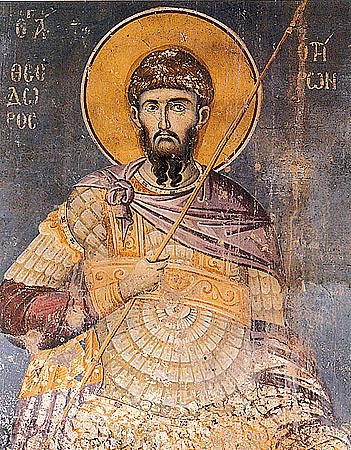 Saint Theodoros Terwn Saint Theodoros Terwn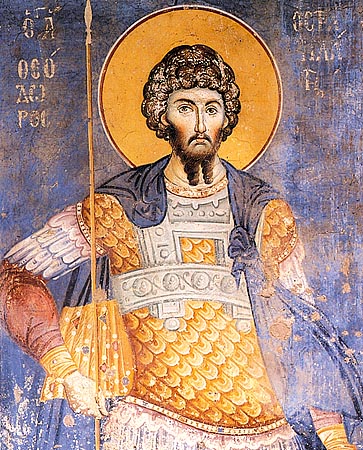 Saint Theodoros o Stratelates Saint Theodoros o Stratelates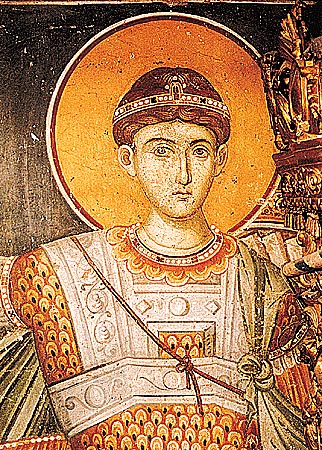 Saint Demetrius Saint DemetriusThese three icons were painted about 1290 in the temple of Prwtatos in Agio Oros(Mount Athos) 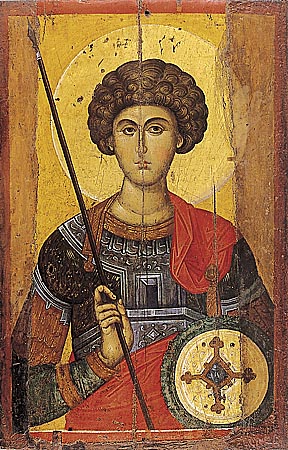 Saint Georgios,icon of 14th cen.,Athens,Byzantine Museum Saint Georgios,icon of 14th cen.,Athens,Byzantine MuseumFollow this link ( http://eib.xanthi.ilsp.gr/gr/icons.asp?cursort=iconTitle&selectFieldValue=&vpage=3 ),it has some interesting,high quality icons. Edited by Patrinos - 14-Sep-2008 at 22:53 |
|||||
|
"Hellenes are crazy but they have a wise God"
Kolokotronis |
|||||
 |
|||||
Byzantine Emperor 
Arch Duke 

Kastrophylax kai Tzaousios Joined: 24-May-2005 Location: United States Online Status: Offline Posts: 1800 |
 Quote Quote  Reply Reply
 Posted: 14-Sep-2008 at 23:06 Posted: 14-Sep-2008 at 23:06 |
||||
|
Patrinos, it is good to see you back at the forum again! Welcome.
The images you posted are really nice. I have seen the frescoes of the the two Theodores before.
The one of Saint George is interesting because of the small rounded shield he carries. This strikes me as being a classicized representation of the shield. By the fourteenth century it was not in use as a functional piece of defensive armor.
Concerning the klibania, Theodore Stratelates' klibanion is an example of the fantastic stylization you see in the late period, with the lamellar pieces in a circular pattern.
I perused the site from which these came and happened upon this image of Saint Merkourios from the Holy Kosmosoteira Church in Ferres, Thrace:
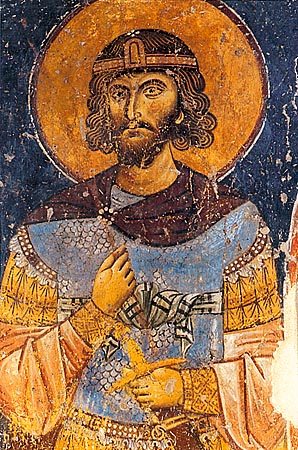 The caption at the site says it was painted in 1152. At any rate, although I could be mistaken, his dress look quite Westernized. Not only does the long-sleeved tunic look this way, but his long curly hairstyle looks like something you would expect to see in England or France in illuminated manuscripts.
|
|||||
 |
|||||
Post Reply 
|
Page <1 14151617> |
| Forum Jump | Forum Permissions  You cannot post new topics in this forum You cannot reply to topics in this forum You cannot delete your posts in this forum You cannot edit your posts in this forum You cannot create polls in this forum You cannot vote in polls in this forum |
Copyright ©2001-2009 Web Wiz
This page was generated in 0.063 seconds.











 Printable Version
Printable Version Google
Google Delicious
Delicious Digg
Digg StumbleUpon
StumbleUpon Windows Live
Windows Live Yahoo Bookmarks
Yahoo Bookmarks reddit
reddit Facebook
Facebook MySpace
MySpace Newsvine
Newsvine Furl
Furl Topic Options
Topic Options